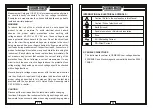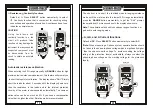
®
®
01
02
I. SAFETY :
TERMS IN THIS MANUAL :
WARNING
Identifies conditions and actions that could result in
serious injury or even death to the user.
CAUTION
Identifies conditions and actions that could cause
damage or malfunction in the instrument.
This manual contains information and warnings that must be
followed for operating the instrument safely and maintaining the
instrument in a safe operating condition. If the instrument is used
in a manner not specified by the manufacturer, the protection
provided by the instrument may be impaired. The meter is
intended only for indoor use.
The meter protection rating, against the users, is double insulation
per IEC/UL/EN61010-1 Ed. 3.0, IEC/EN61010-2-030 Ed. 1.0,
IEC/EN61010-2-033 Ed. 1.0, IEC/UL/EN61010-031 Ed. 1.1 and
CAN/CSA-C22.2 No. 61010-1-12 Ed. 3.0 to Cat III 1000 Volts
AC & DC and Category IV 600 Volts AC & DC.
Terminals (to COM) measurement category:
V / A / mA
m
A :
Category III 1000 Volts AC & DC, & Category IV
600 Volts AC & DC.
Measurement Category IV (CAT IV)
is for measurements
performed at the source of the low-voltage installation. Examples
are electricity meters and measurements on primary over current
protection devices and ripple control units.
Measurement Cat III (CAT III)
is for measurements performed in
the building installation. Examples are measurements on
distribution boards, circuit- breakers,wiring, including cables, bus-
bars, junction boxes, switches, socket-outlets in the fixed
installation, and equipment for industrial use and some other
equipment, for example, stationary motors with permanent
connection to the fixed installation.
Per IEC61010-1 Measurement Category
TAKE MEASUREMENT CAREFULLY AND YOU’LL
SPARE YOUR METER AND YOURSELF, SOME PAIN
Nearly every electrical engineer has a hand held digital multimeter
(DMM). We sometimes take them for granted, until we damage them
or “burn them out” if you incorrectly connect your DMM to a circuit or
have the DMM on wrong setting, you damage the meter and possibly
hurt yourself. You can also get into trouble if you try to measure the
voltage across a charged capacitor.
To prevent excess current from flowing through your meter, always
disconnect the test leads from the circuit under test whenever you
change DMM functions, Set your meter to the correct function, say
current and its highest range for the setting, say 10A. Next, connect
the test leads before you apply power to the circuit. To be safe, start
by setting your meter to its highest range first.
If you are measuring current in industrial environment, you can easily
exceed those ratings. The best way to avoid damage is to use a
clamp meter or to connect a clamp attachment to your DMM.
Even if you correctly insert your DMM into the circuit, you can still
damage your meter. Don’t try to measure current in excess of your
meter’s capacity. Handheld DMMs usually have a maximum current
rating of 10A or 20A.
DMM users frequently burn their meters by trying to measure
current the same way as they measure voltage, Remember, you
measure voltage across a circuit, and current through a circuit. When
you use the current input, your DMM becomes a lower impedance
circuit element. If you accidentally connect this low impedance path
across your circuit, you’ll effectively short-circuit it. You can, therefore
send high current through your meter and severely damage it. Unless
the meter has a fused input, you can even get an explosion or fire.















